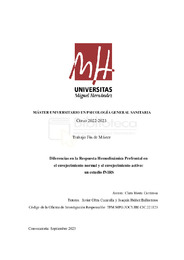Por favor, use este identificador para citar o enlazar este ítem:
https://hdl.handle.net/11000/31933
Diferencias en la Respuesta Hemodinámica Prefrontal en el envejecimiento normal y el envejecimiento activo:
un estudio fNIRS
Título :
Diferencias en la Respuesta Hemodinámica Prefrontal en el envejecimiento normal y el envejecimiento activo:
un estudio fNIRS |
Autor :
Iñesta Carrizosa, Clara |
Tutor:
Oltra-Cucarella, Javier 
Ibáñez Ballesteros, Joaquín |
Editor :
Universidad Miguel Hernández de Elche |
Departamento:
Departamentos de la UMH::Psicología de la Salud |
Fecha de publicación:
2023-09 |
URI :
https://hdl.handle.net/11000/31933 |
Resumen :
Introducción: El progresivo envejecimiento de la población y la ausencia de tratamientos eficaces para la demencia aumentan la necesidad de detección temprana de alteraciones cognitivas y biomarcadores de disfunción cerebral. Considerando la evidencia sobre el efecto protector de un envejecimiento activo en el cerebro y el rendimiento cognitivo, el objetivo de este estudio es analizar diferencias en la respuesta hemodinámica prefrontal en un grupo de personas mayores cognitivamente activas (GA) y un grupo de personas mayores de la comunidad (GC), mediante la técnica espectroscopía de infrarrojo cercano (fNIRS).
Método: El GA (n=16) y el GC (n=16) fueron evaluados con una batería de tests neuropsicológicos y una escala de actividades cognitivamente estimulantes, y se realizó un registro de su actividad cerebral con un dispositivo NIRS. Se emplea una tarea mental cíclica para inducir oscilaciones y analizar cambios en la actividad hemodinámica cerebral y extra-cerebral.
Resultados: No se hallaron diferencias en el rendimiento cognitivo. Se encontraron diferencias significativas en la realización de actividades cognitivamente estimulantes, así como en el poder espectral de la señal cerebral y la señal superficial, con mayor amplitud en el GC. Esta diferencia sugiere una posible respuesta de hiperactivación compensatoria en las personas del GC.
Conclusiones: Este estudio confirma el efecto protector de un envejecimiento activo en el cerebro y la salud cerebrovascular, así como la eficacia de la técnica fNIRS para desarrollar biomarcadores tempranos de anomalías en la respuesta hemodinámica de adultos mayores, con el objetivo de prevenir patologías como la demencia.
Introduction: The progressive aging of the population and the absence of effective treatments for Dementia highlights the need for early identification of cognitive impairment and biomarkers of brain dysfunction. Considering the evidence on the protective effect of active aging on the brain and cognitive performance, the aim of this work is to analyze the differences on the prefrontal hemodynamic response in a group of cognitively active older adults (GA) and a group of older adults from the community (GC), using the near infrared spectroscopy technique (fNIRS).
Method: The GA (n=16) and the CG (n=16) were assessed with a battery of neuropsychological tests and a scale of cognitively stimulating activities, and their brain activity was recorded with a NIRS device. A cyclic mental task is used to induce oscillations and analyze changes in cerebral and extracerebral hemodynamic activity.
Results: No differences in cognitive performance between the groups were found. Significant differences were found in the performance of cognitively stimulating activities and in the spectral power of the brain signal and the surface signal, with greater amplitude in the CG. This difference suggests a possible compensatory overactivation response in the CG subjects.
Conclusions: The study confirms the protective effect of active aging on the brain and cerebrovascular health, as well as the efficacy of the fNIRS technique to develop early biomarkers of abnormalities in the hemodynamic response of older adults with the aim of preventing pathologies such as dementia.
|
Palabras clave/Materias:
Envejecimiento normal
envejecimiento activo
evaluación neuropsicológica
biomarcadores
actividad hemodinámica
Normal aging
active aging
neuropsychological assessment
biomarkers
hemodynamic activity |
Área de conocimiento :
CDU: Filosofía y psicología: Psicología |
Tipo documento :
application/pdf |
Derechos de acceso:
info:eu-repo/semantics/openAccess
Attribution-NonCommercial-NoDerivatives 4.0 Internacional |
Aparece en las colecciones:
TFM- M.U en Psicología General Sanitaria
|
 La licencia se describe como: Atribución-NonComercial-NoDerivada 4.0 Internacional.
La licencia se describe como: Atribución-NonComercial-NoDerivada 4.0 Internacional.
 La licencia se describe como: Atribución-NonComercial-NoDerivada 4.0 Internacional.
La licencia se describe como: Atribución-NonComercial-NoDerivada 4.0 Internacional.
.png)
